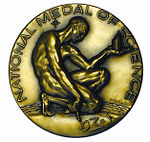Национальная научная медаль США
Эту страницу предлагается переименовать в «Национальная медаль науки». |
Национальная научная медаль (англ. National Medal of Science; в некоторых источниках трактуется как Национальная медаль науки) — американская государственная награда за выдающийся вклад в области биологических, физических, математических, технических, химических, общественных или поведенческих наук.
| Национальная научная медаль США | |
|---|---|
| англ. National Medal of Science | |
 |
|
| Страна |
|
| Тип | научная награда[d] и медаль |
| Кем вручается | Национальный научный фонд |
| Статус | вручается |
| Статистика | |
| Первое награждение | 1962 |
| Последнее награждение | 2014 |
| Сайт | nsf.gov/od/nms/me… (англ.) |
Общие сведения править
Медаль присуждается Президентом США по рекомендации Комитета Национальной научной медали, состоящего из 12 учёных и инженеров. Медаль была учреждена 25 августа 1959 года Конгрессом США специальным Законом (Public Law 86-209) и первоначально предназначалась только для естественнонаучных областей ("physical, biological, mathematical, or engineering sciences"). В 1980 году этот перечень был дополнен общественными дисциплинами (social and behavioral sciences) по Закону от 12 декабря (Public Law 96-516). Вручение происходит в Белом Доме.
Знаменитые лауреаты править
К ноябрю 2009 года медаль получили более 450 человек, среди них Нобелевские лауреаты и другие известные учёные, в том числе Владимир Козьмич Зворыкин, Георгий Богданович Кистяковский и Игорь Иванович Сикорский.
| Год | Лауреат | Оригинальная формулировка вклада |
|---|---|---|
| 1963 | Вэнивар Буш | «For his distinguished achievements in electrical engineering, in the technology of computing machines, in the effective coupling of the physical and life sciences; and in his mobilizing science, engineering and education in enduring ways in the service of the Nation.» |
| 1963 | Норберт Винер | «For his marvellously versatile contributions, profoundly original, ranging within pure and applied mathematics, and penetrating boldly into the engineering and biological sciences.» |
| 1969 | Эрнст Майр | «For notable contributions to systematics, biogeography, and the study of birds, and especially for great work on the evolution of animal populations.» |
| 1970 | Барбара Мак-Клинток | «For establishing the relations between inherited characters in plants and the detailed shapes of their chromosomes, and for showing that some genes are controlled by other genes within chromosomes.»[1] |
| 1974 | Лайнус Полинг | «For the extraordinary scope and power of his imagination, which has led to basic contributions in such diverse fields as structural chemistry and the nature of chemical bonding, molecular biology, immunology, and the nature of genetic diseases.» |
| 1975 | Вернер фон Браун | «For his work in making the liquid-fuel rocket a practical launch vehicle and for individual contributions to a series of advanced space vehicles, culminating in the Saturn series that made the Apollo program possible.»* |
| 1976 | Эдвард Осборн Уилсон | «For his pioneering work on the organization of insect societies and the evolution of social behavior among insects and other animals.» |
| 1979 | Северо Очоа | «Ochoa continued research on protein synthesis and replication of RNA viruses until 1985, when he returned to Spain and gave advice to Spanish science policy authorities and scientists.» |
| 1979 | Ричард Фейнман | «In recognition of his essential contributions to the quantum theory of radiation and to his illumination of behavior of constituents of the atom, of the atomic nucleus, and of the subnuclear particles.» |
| 1982 | Эдвард Теллер | «For his outstanding contribution to molecular physics, understanding the origin of stellar energy, the theory and application of fusion reaction, the field of nuclear safety, and for his continued leadership in science and technology.» |
| 1987 | Гарри Игл | «For his research in the development of reproducible conditions for the growth in culture of human and animal cells.» |
| 1989 | Самуэль Карлин | «For his broad and remarkable researches in mathematical analysis, probability theory and mathematical statistics, and in the application of these ideas to mathematical economics, mechanics, and population genetics.» |
| 1990 | Леонид Гурвич | «For his pioneering work on the theory of modern decentralized allocation mechanisms.» |
| 1997 | Джеймс Дьюи Уотсон | «For five decades of scientific and intellectual leadership in molecular biology, ranging from his co-discovery of the double helical structure of DNA to the launching of the Human Genome Project.» |
См. также править
Примечания править
- ↑ US NSF — The President’s National Medal of Science: Recipient Details. Дата обращения: 25 июля 2010. Архивировано 24 октября 2011 года.